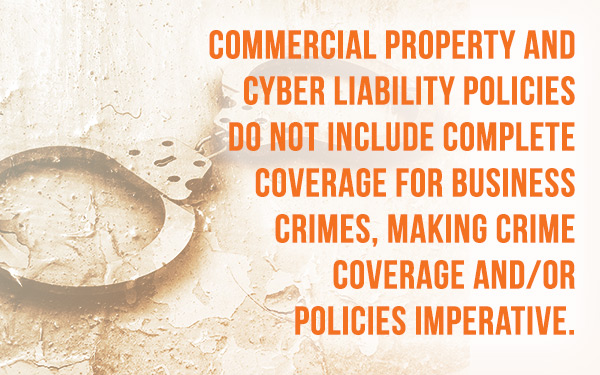Diving Into Crime Insurance
August 12, 2021
Commercial crime or business crime insurance is an essential coverage to have, as it provides protection for losses due to fraud, embezzlement, theft, forgery, or any other business crime. Statistics show that every year businesses lose $50 billion due to employee theft and more than 30% of business bankruptcies are a result of employee theft. This coverage can protect against losses in cash, assets, merchandise, or other property. While there may be a small amount of crossover in coverage between a commercial property policy or cyber liability policy, these policies typically do not include coverage for business crimes or only offer one small element of coverage. For this reason, it is imperative to either purchase a package policy that may have crime coverage built-in or have a separate crime policy in place.
A standalone crime policy can include various coverages, and businesses have the ability to decide what coverages they wish to purchase based on their individual needs. The vast majority of crime losses fall under employee dishonesty coverage. Therefore, the vast majority of premium tends to be charged for this coverage line, and other coverages can typically be added for very little premium.
Below we take a deeper dive into each coverage to provide a better understanding of what types of claims fall under each coverage.
Employee Theft or Dishonesty
Employee theft is also called employee dishonesty coverage and protects against financial loss caused by property thefts committed by employees. Statistics show that 27% of employee fraud occurs in government, healthcare, construction, and service industries, while 23% happens in finance, technology, and other sectors.
ERISA Fraud or Dishonesty
ERISA fraud or dishonesty provides coverage for employees acting as plan officials of ERISA employee benefit plans. You can satisfy ERISA requirements by placing an ERISA bond, or typically coverage can be added into the crime policy, which would fulfill the bond requirements. It is important to know that a bond is not needed if the crime policy includes ERISA coverage, as it will replace the bond.
Employee Theft of Client Property
Employee theft of client property provides coverage for property theft sustained by the client that your employee commits. This coverage is relevant for businesses that are providing services on their client’s premises (e.g., housecleaning/janitorial companies, home healthcare services, etc.).

Forgery or Alteration
Forgery or alteration covers losses that arise from dishonesty in writing, signing, or altering checks, bank drafts, and other financial documents. For example, an employee could take a check that was made out to you, make it payable to themselves, and deposit the check into their personal account. It can also cover claims related to credit, charge, and debit cards.
On-Premises
On-premises coverage is intended to provide coverage for theft of money or securities located inside your premises or financial institution, and committed by a person physically inside your premises or financial institution.
In Transit
In transit provides coverage for money and securities that are stolen from a delivery person, messenger service, or armored vehicle while outside of your premises.
Money Orders and Counterfeit Money
Money orders and counterfeit money coverage responds when your business has accepted cash, a money order, or a check that looked legitimate but was proven later to be counterfeit.
Computer Fraud & Computer Program and Electronic Data Restoration Expense
Computer fraud will pay for the loss of money, securities, and other property directly caused by computer fraud. Meanwhile, computer program and electronic data restoration expense coverage is intended to provide coverage to restore or replace damaged or destroyed computer programs or electronic data caused by a computer violation. While a crime policy may include a small sublimit for these coverages, it is prudent to purchase a standalone cyber liability policy that will provide much broader protection with higher limits.
Funds Transfer Fraud
Funds transfer fraud covers funds that are fraudulently transmitted electronically or telephonically to a financial institution by someone other than you and without your knowledge or consent.
Personal Accounts Protection
Personal accounts protection is less common in crime policies and typically provides a very low sublimit when included. It provides coverage for your personal accounts. While rare, it can feature some identity fraud expense reimbursement coverage as well.
Claim Expense
Claim expense, when offered, is typically a small sublimit of $5,000 or $10,000. This coverage is intended to cover the costs and expenses of hiring an outside accountant, attorney, consultant, or other specialist to determine the amount and extent of the loss. Hiring experts can get expensive, and we see this coverage used quite often. However, not all crime carriers offer claim expense in their policies.
Social Engineering
Over the last several years, we have begun to see social engineering being offered by crime carriers as a sublimit. It is important to note that not all carriers have the capability to offer coverage. Unfortunately, social engineering crimes are very common and occur when a fraudulent email, fax, letter, or even a phone call appears to be from a trusted source and misleads an employee into sending money or diverting payment based on the fraudulent information received. Not to be confused with funds transfer fraud, which involves a malicious hack, social engineering happens when an employee is intentionally misled. This is another coverage that can crossover with your cyber liability policy and, while your crime policy may provide a small amount of social engineering coverage, it is not as broad or comprehensive as your cyber policy.
As you can see, crime insurance can be a complicated and multifaceted coverage, and the included coverages can vary widely based on your organization’s individual needs. Remember that terms and conditions will also differ from policy to policy and carrier to carrier. Please be sure to reach out to Parker, Smith & Feek if you have questions about what coverages your crime policy includes.
Resources and References
- An Inside Job, U.S. Department of Commerce. https://www.awci.org/cd/pdfs/9004_g.pdf
- Are happier employees less likely to steal?, Service Management Group. https://www.smg.com/docs/default-source/default-document-library/resources/are-happier-employees-less-likely-to-steal.pdf?sfvrsn=c356c331_8
- Employee Fraud Prevalent in the Workplace: Ernst & Young Study, Ipsos. https://www.ipsos.com/en-ca/employee-fraud-prevalent-workplace-ernst-young-study
The views and opinions expressed within are those of the author(s) and do not necessarily reflect the official policy or position of Parker, Smith & Feek. While every effort has been taken in compiling this information to ensure that its contents are totally accurate, neither the publisher nor the author can accept liability for any inaccuracies or changed circumstances of any information herein or for the consequences of any reliance placed upon it.




